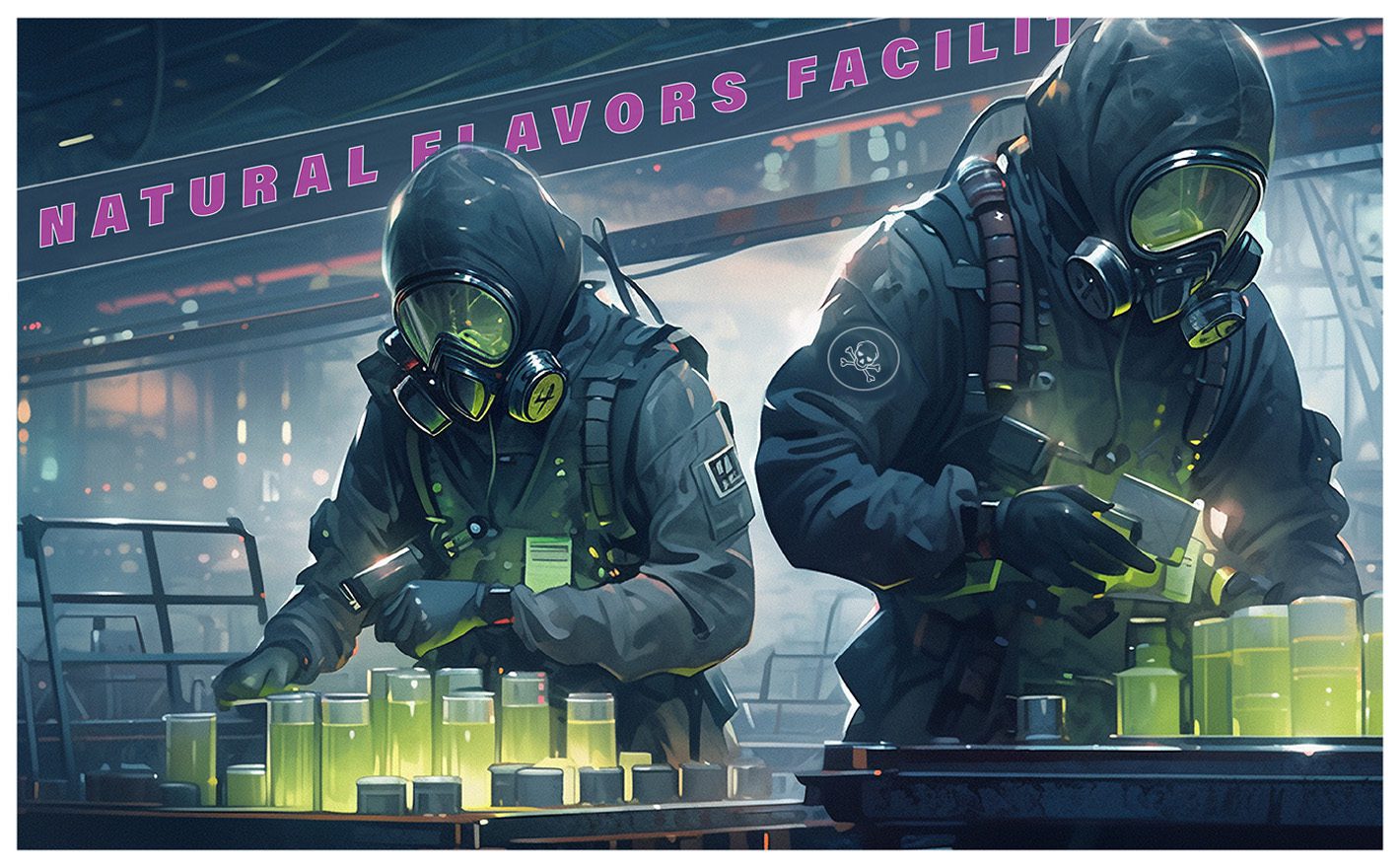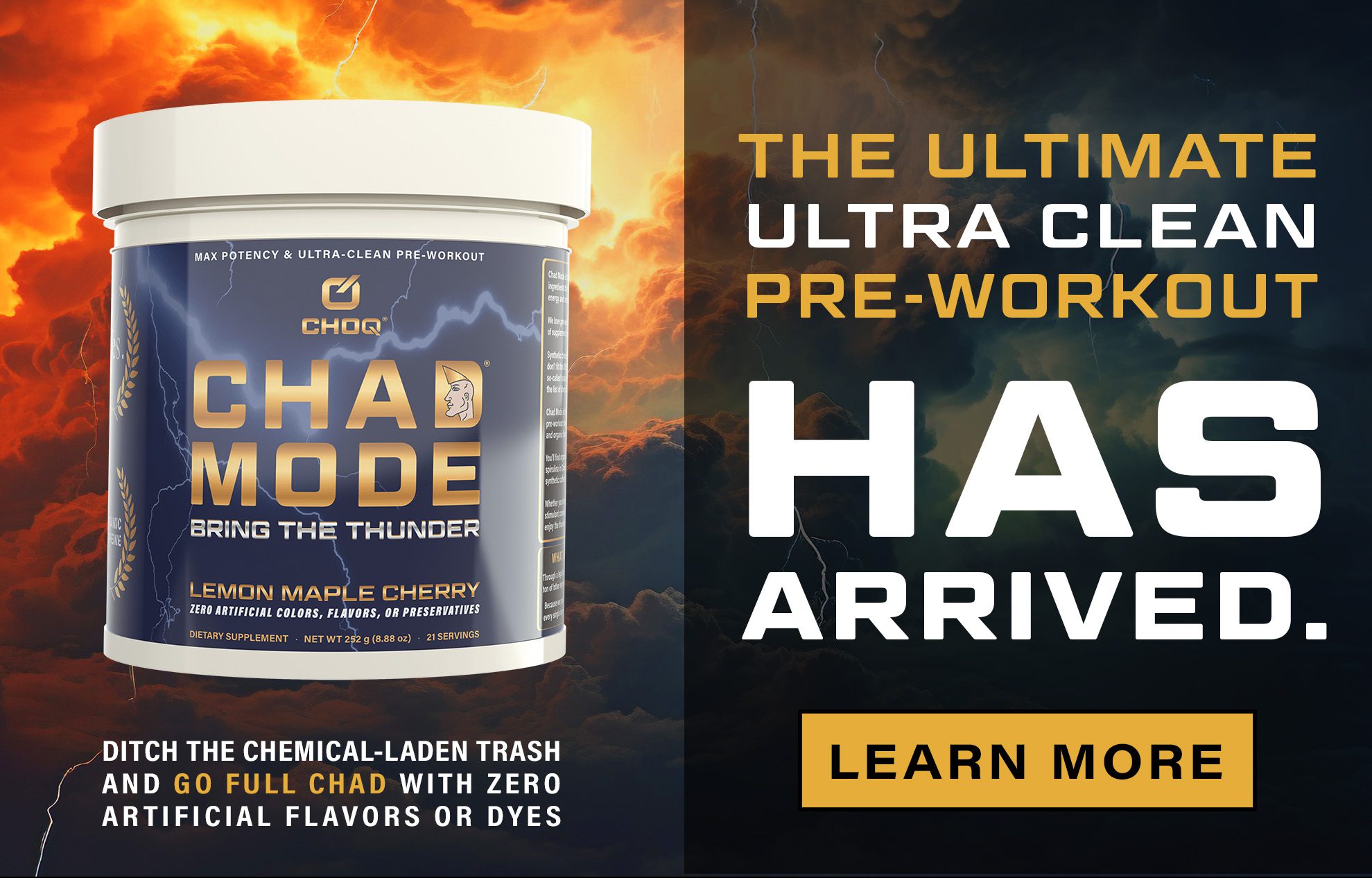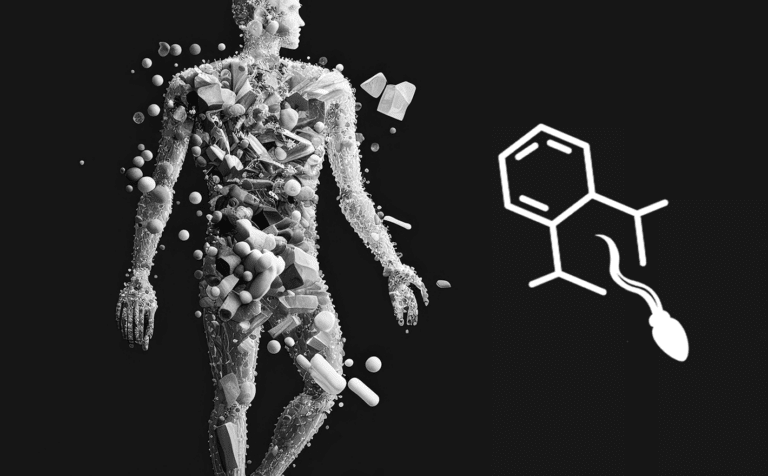Are natural flavors bad for you? Well, some of them are known carcinogens, but it’s complicated. Are they natural? Absolutely not.
These days, most health-conscious folks are fully aware that chemical food additives like artificial flavorings, dyes, and sweeteners are bad news, but unfortunately, too many people are still being duped by so-called ‘natural flavors’.
We did a ton of research on them when we were formulating our ultra-clean pre-workout product, Chad Mode, and were shocked by what we found.
These mysterious compounds are as ubiquitous as they are poorly understood. Next time you’re at a health foods store, pick up nearly anything that’s not produce or meat. There’s a good chance that you’ll see the phrase ‘natural flavors’ somewhere in the ingredients.
But what does the word ‘natural’ even mean?
How often do you see phrases like ‘natural beef flavor’, ‘natural vanilla flavor’, or ‘natural smoke flavor’ on a label and imagine actual cows, vanilla beans, or backyard grills?
The reality of where these flavors come from is nothing like what you’re imagining.
‘Natural’ is easily one of the most misused words in the English language. In the wide world of marketing, it’s often bandied about with little to no regard for its actual meaning.
According to Consumer Reports, over 60% of people have no idea that the word is virtually meaningless, and assume that it indicates specific things about a product, such as GMO- or pesticide-free:
“When you see the words “natural” or “all-natural” on a food label do you think, no artificial ingredients? No GMOs? No pesticides? No antibiotics? In a recent survey (PDF) of more than 1,000 adults from the Consumer Reports National Research Center, nearly two-thirds of people did.
Truth is, on processed foods, the “natural” word doesn’t have to mean any of those things. In fact, the term is essentially meaningless.”
Interestingly, the Food and Drug Administration does not have an official definition for ‘natural’, but it does have a definition for ‘natural flavors’. Before we get to that, though, let’s talk a little bit about just how hard it is to avoid these chemicals.
Natural flavors are frequently found in products like:
- Energy drinks
- Pre-workouts
- Protein bars / powders
- Snacks like chips and crackers
- ‘Natural’ candies and gums
- Vegan meat substitutes
- Baked goods
- Nearly all processed foods
Companies rely on your ignorance of how things actually work behind the scenes to deceive you into thinking you’re eating something healthier. Just because a product has a colorful illustration of a farm, some happy cows, or a stylized sunset on it, that doesn’t mean it’s any better for you.
It’s way too easy to see a box of crackers that say they’re ‘all-natural’–probably made by someone with a non-threatening name like ‘Bob’ or ‘Kathy’–and suddenly find yourself filled with more than enough confidence to merrily toss it into your cart without inspecting the label.
Is it really worth all that extra time and effort, to read the full ingredients list before you buy something? That sounds like a TON of work.
Well, we’ve got one word for you: carcinogen.
Just what are natural flavors, and are they dangerous?
According to the FDA, the term ‘natural flavor’ means any molecule that is used principally for flavoring and derived from a live organism (which technically includes everything from apples to beaver’s anal glands to E. coli).
This isn’t quite the whole picture, though, because of something called ‘incidental ingredients’. These are non-flavoring ingredients, such as preservatives, emulsifiers, and solvents, and by law they’re allowed to be 100% artificial.
Not only can these ‘incidental’ natural flavor additives be based on petroleum or other hazardous materials, they’re even allowed to comprise the majority of the natural flavor mixture.
So, next time you’re about to take a scoop of that watermelon-flavored pre-workout that says ‘all-natural’ on the label, be aware that more than 90% of the natural flavor blend inside of it could be made of synthetic chemicals like:
- Polysorbate 80 – shown in research to disrupt the microbiome and increase the penetration of pathogenic bacteria through the gut lining
- Propylene Glycol – petroleum-derived chemical commonly used as antifreeze that has been shown to increase allergic reactions such as asthma and eczema
- BHA (Butylated HydroxyAnisole) – also petroleum-based; shown to be carcinogenic in rats
- Benzoic Acid – preservative that can degrade into an extremely potent carcinogen known as benzene
Ignorance is bliss, right?
More on the dangers of natural flavors later. First, let’s define exactly what these flavors are, and how they vary by region.
How the United States and the rest of the world define ‘natural flavors’
Natural and artificial flavors are often the same chemical compounds, but by law natural flavors must be made from natural raw materials.
Here’s the FDA’s official definition of ‘natural flavors’:
“The essential oil, oleoresin, essence or extractive, protein hydrolysate, distillate, or any product of roasting, heating or enzymolysis, which contains the flavoring constituents derived from a spice, fruit or fruit juice, vegetable or vegetable juice, edible yeast, herb, bark, bud, root, leaf or similar plant material, meat, seafood, poultry, eggs, dairy products, or fermentation products thereof, whose significant function in food is flavoring rather than nutritional.”
If this sixty-six-word-long sentence confuses the heck out of you, then that’s perfectly natural (pun intended).
For a layperson to understand it, they’d have to know exactly what things like distillates, hydrolysates, and enzymolysis are. Well over 99.9% of people do not have the training in chemistry to understand this.
In our research for this article, we peeked behind the curtain of inscrutable chemistry jargon and found the truth: that manufacturers can basically do whatever they want to the raw materials as long as they start off with some kind of living organism.
Here’s a screenshot from an article by chemical sciences company Sigma Aldrich on natural flavor definitions according to different regions:
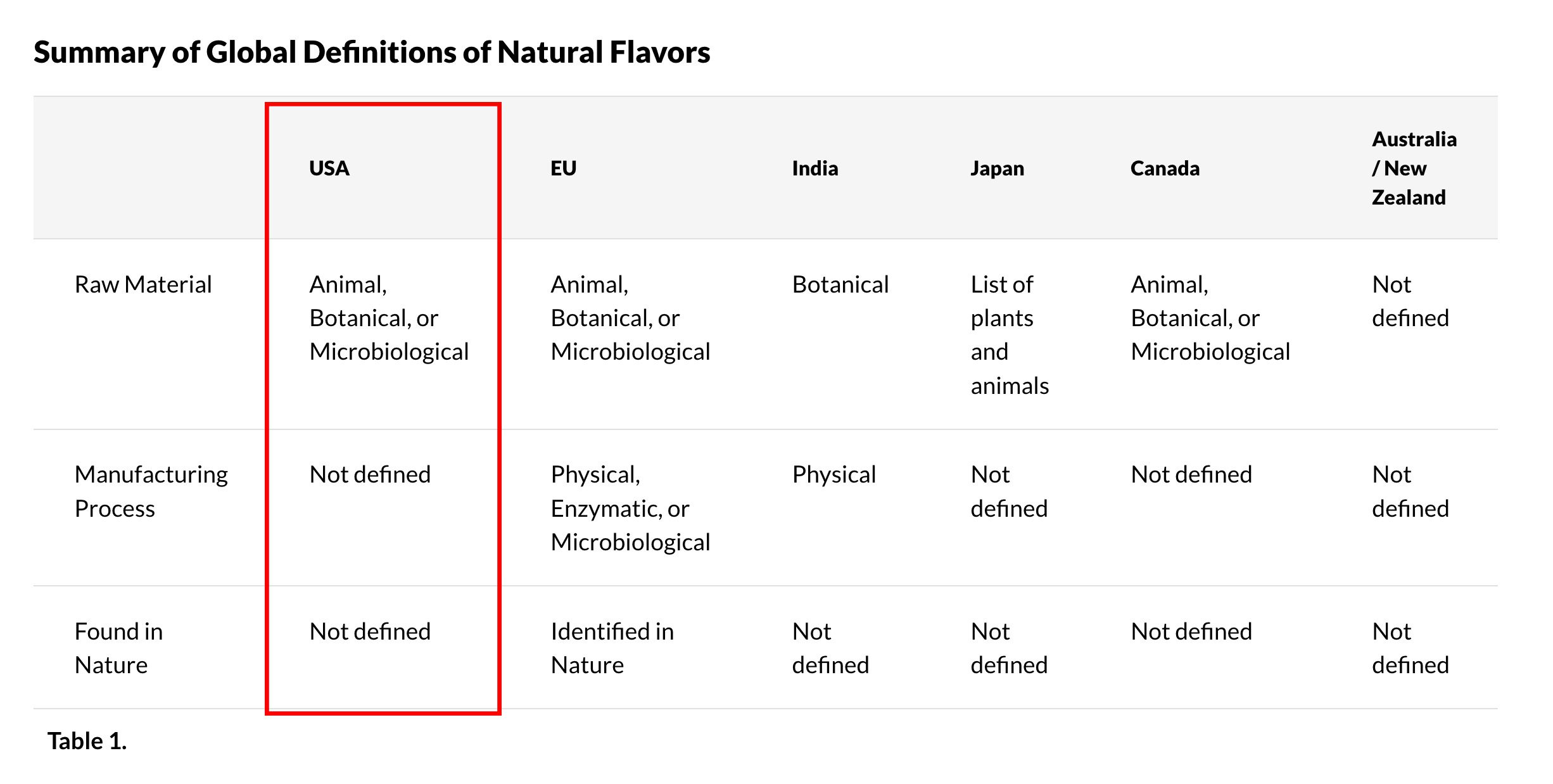
According to the chart above, it looks like the manufacturing processes allowed for natural flavors are so loosely defined by the FDA that they almost equate to “make whatever you want however you want”.
Shockingly, the end result does not even have to be a molecule that actually occurs in nature. Natural indeed.
Again, the only thing that matters according to the FDA is that the raw material is one of the following:
- Plant
- Animal
- Microorganism
Such a broad description might raise some eyebrows once one contemplates that ‘microorganism’ can mean literally any bacteria, virus, or fungus, including those that have been genetically modified (which usually means they’re reprogrammed to excrete any kind of chemical a scientist can dream of).
And remember, just because natural flavors might come from a plant or animal source, that doesn’t mean they’re plants or animals that you would ever eat. Google ‘castoreum vanilla’ if you dare.
Not surprisingly, the US is among the countries with the absolute lowest standards.
Notice how the EU, India, and Japan have way stricter guidelines. For example, European natural flavors have to be naturally occurring molecules, and in India you can only use ‘physical’ manufacturing processes, which means something more akin to flavors being extracted than made through heavy chemical manipulation.
But what about natural flavors in organic products? Surely they’re legit, right? Well, kind of.
Organic natural flavors: are they any better?
According to the Environmental Working Group, a non-profit watchdog organization, organic natural flavors are in fact a little different in terms of what’s allowed to be in them.
In organic certified products, the natural flavor additives can’t be synthetic, so–unlike regular natural flavors–they can’t have stuff like BHT, BHA, benzoic acid, or polysorbate 80 in them.
The flavorings themselves, however, don’t need to be organic (although they can be), because only 95% of an organic certified product has to be organic according to regulations, and natural flavors are so potent that they’re almost always less than 5% of the weight of the product.
So yeah, there’s still plenty of room for these mystery chemicals in your organic products.
The dangers of natural flavors: why are carcinogens like aldhehydes and benzene in them?
When we started digging into natural flavors, one of the major themes we found was that several of the chemicals in them are related to benzene. This includes some of the incidental ingredients we mentioned before, but also flavors like benzaldehyde, which is one of the most commonly used of all natural flavors.
If ‘aldehyde’ sounds like a foreign yet strangely familiar word, think about that one chemical they use for embalming fluid. Yep, that’s the one.
Notably, benzene is one of the very nasty carcinogens that emanate from cigarette smoke. It’s also the reason that gasoline has a sweet aroma that some even find pleasant.
According to this article by the American Cancer Society, benzene:
- Has a sweet odor
- Is one of the 20 most widely used chemicals in the US
- Is commonly used to make plastic, rubber, drugs, pesticides, dyes, and a wide variety of chemicals
- Has been identified by the EPA, NTP (National Toxicology Program), and IARC (International Agency for Research on Cancer) as a human carcinogen
- Can cause anemia, immunosuppression, reproductive harm, and other problems
Natural flavor proponents and apologists will respond that the quantities of these chemicals are low enough to make them safe, but if you were to ask your doctor, “what’s a safe amount of cigarettes that I can smoke per week?”, it’s doubtful you’d get any answer other than “zero”.
Carcinogenic chemicals found in cherry soda
Next time you’re shopping and see a cherry-flavored drink on the shelf, you might want to pause before you throw it in the cart. Used to impart a cherry or almond flavor / aroma, benzaldehyde has been shown to degrade into benzene.
To be fair, this compound does occur naturally in fruit, but–as we know from sugar, cocaine, and caffeine–things get a heck of a lot more dangerous once humans figure out how to isolate them and use them in large quantities. They may also be more likely to become chemically unstable once they’re used in their pure form.
Here are some interesting points from an article titled “Has mystery of why benzene forms in cherry-flavoured soft drinks been solved?”:
- A consumer organization found up to 4.6 micrograms of benzene per liter in the various cherry sodas they tested
- Though that’s many times less than what a smoker gets per day, there is still no safe level of benzene exposure
- Light is largely responsible for this chemical reaction, and they recommend all products with benzaldehyde be kept in light-proof containers
So if you’re not worried about your kid’s cherry soda outgassing an extremely potent carcinogen as soon as you pour it into a glass, you might want to switch to something healthier.
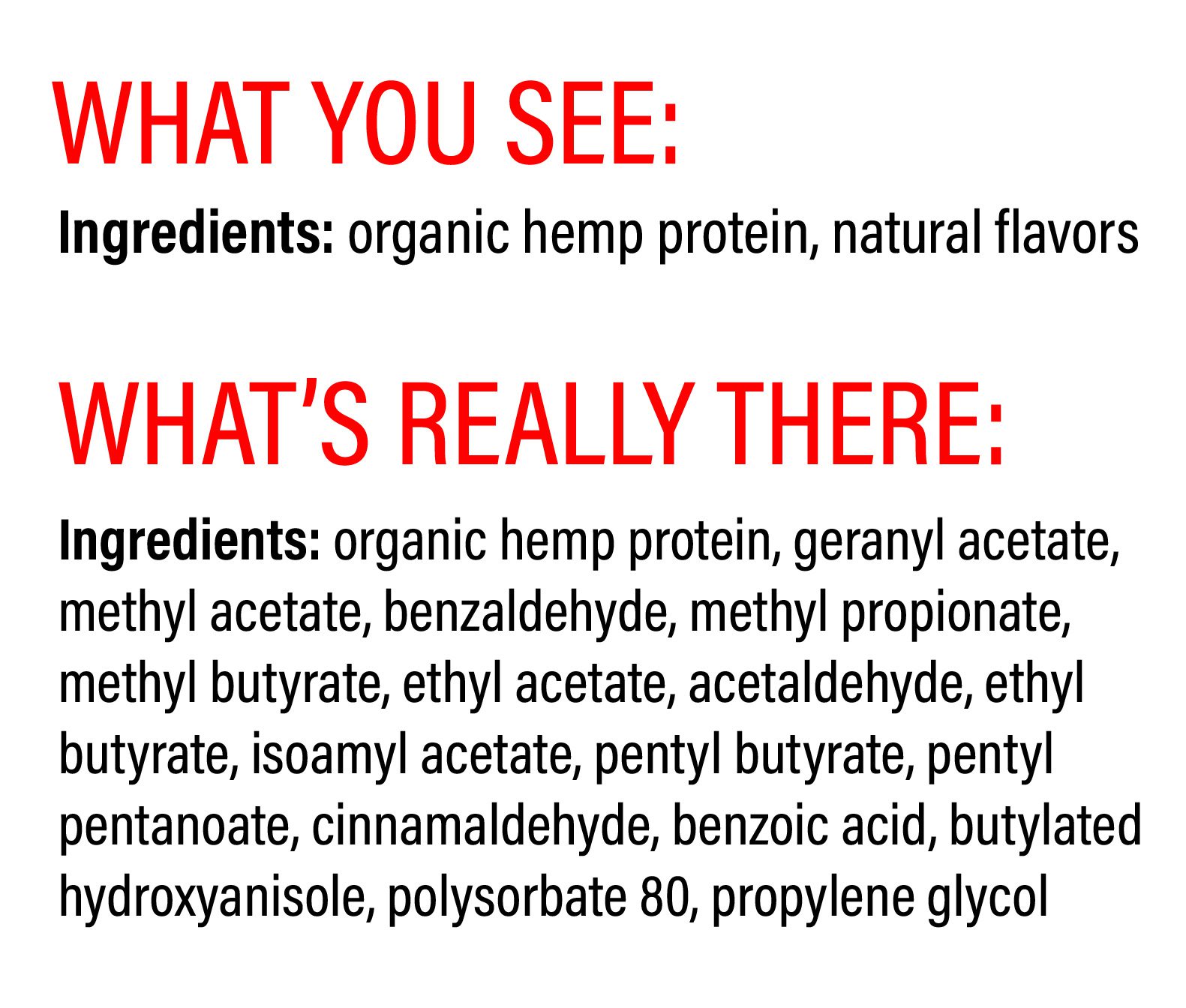
Natural flavors as a transparency issue
What’s really hiding behind the term ‘natural flavors’? Sometimes, it’s a blend of over a hundred different chemical compounds, but you don’t get to know which ones.
Lots of supplement companies use natural flavors, even some of the ones that are overall really legit. While it’s possible that they may be formulating with the ones that are less questionable, there’s really no way to know.
One of the many reasons we don’t use natural flavors at CHOQ is because we practice full-disclosure labeling, which means that we list every single ingredient, even if we don’t have to by law.
This also means that we don’t use proprietary blends (check out this blog for a deep dive on why we think they should be illegal).
Just like ‘fragrance’, terms like ‘natural flavors’ and ‘artificial flavors’ are really just huge obfuscations. They’re blanket terms that permit the manufacturer to hide the actual identities of the ingredients.
If companies actually listed every single molecule that was in each flavor blend, then their ingredient lists would take up the entire label. The mockup you just saw would pale in comparison.
Thus, the use of natural flavors goes against not only our ingredient quality standards but also our transparency standards.
There are literally thousands of different chemicals that fall under the natural flavor umbrella. It could be that only a tiny fraction of them pose any health concern, but even if that were the case, you’d have no way of knowing which ones are in the product you’re about to use (also remember that benzaldehyde is one of the most commonly used).
So yeah, if you’re wondering why the government lets companies include so many hidden and potentially harmful ingredients in supplements, foods, and beverages, then just know that we at CHOQ are wondering the same thing.
If you’d like to learn more about how to live a chemical-free lifestyle, then you might enjoy these articles:
